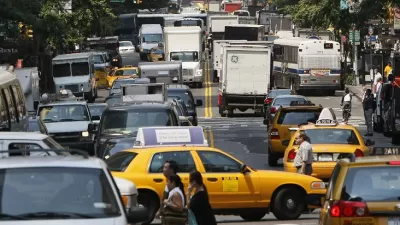The city's plan to charge vehicles entering Manhattan's central business district could reduce traffic and raise $1 billion a year for the city's transportation infrastructure.

In an op-ed in the New York Daily News, Betsy Plum and Kate Slevin argue that New York City's long-awaited plan to institute congestion pricing for vehicles entering Manhattan's central business district is "a welcome milestone" for a strong regional recovery.
"Now that the doors are open for quick action, the MTA should immediately begin determining the nuts and bolts of what New York’s program looks like — fixing how much tolls will cost, whether they’ll vary by time of day, who pays what," write Plum and Slevin. The authors contend that, "[w]ith forward thinking and hard work that starts now," the city could start its program and start earning revenue in as little as a year.
If instituted, the program would follow in the footsteps of London, Singapore, Stockholm, and other traffic-choked cities. "Congestion pricing is projected to raise about $1 billion annually for new subway signals, cars, elevators, buses and commuter rail. It will alleviate congestion worth an estimated $20 billion annually to residents." Additionally, the reduced traffic could lead to faster buses, "quicker emergency response times, less pollution, fewer carbon emissions, less chance of deadly collisions, less of a burden on businesses and customers and less stress for businesses, drivers, commuters and residents."
FULL STORY: Congestion pricing, more than ever

Planetizen Federal Action Tracker
A weekly monitor of how Trump’s orders and actions are impacting planners and planning in America.

Maui's Vacation Rental Debate Turns Ugly
Verbal attacks, misinformation campaigns and fistfights plague a high-stakes debate to convert thousands of vacation rentals into long-term housing.

San Francisco Suspends Traffic Calming Amidst Record Deaths
Citing “a challenging fiscal landscape,” the city will cease the program on the heels of 42 traffic deaths, including 24 pedestrians.

Defunct Pittsburgh Power Plant to Become Residential Tower
A decommissioned steam heat plant will be redeveloped into almost 100 affordable housing units.

Trump Prompts Restructuring of Transportation Research Board in “Unprecedented Overreach”
The TRB has eliminated more than half of its committees including those focused on climate, equity, and cities.

Amtrak Rolls Out New Orleans to Alabama “Mardi Gras” Train
The new service will operate morning and evening departures between Mobile and New Orleans.
Urban Design for Planners 1: Software Tools
This six-course series explores essential urban design concepts using open source software and equips planners with the tools they need to participate fully in the urban design process.
Planning for Universal Design
Learn the tools for implementing Universal Design in planning regulations.
Heyer Gruel & Associates PA
JM Goldson LLC
Custer County Colorado
City of Camden Redevelopment Agency
City of Astoria
Transportation Research & Education Center (TREC) at Portland State University
Jefferson Parish Government
Camden Redevelopment Agency
City of Claremont





























